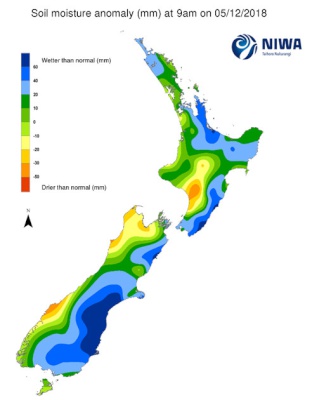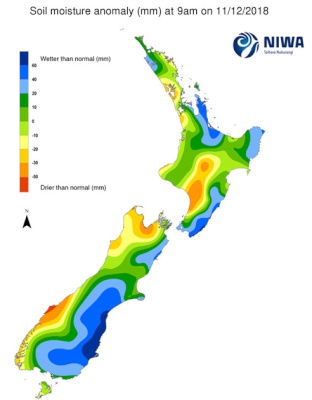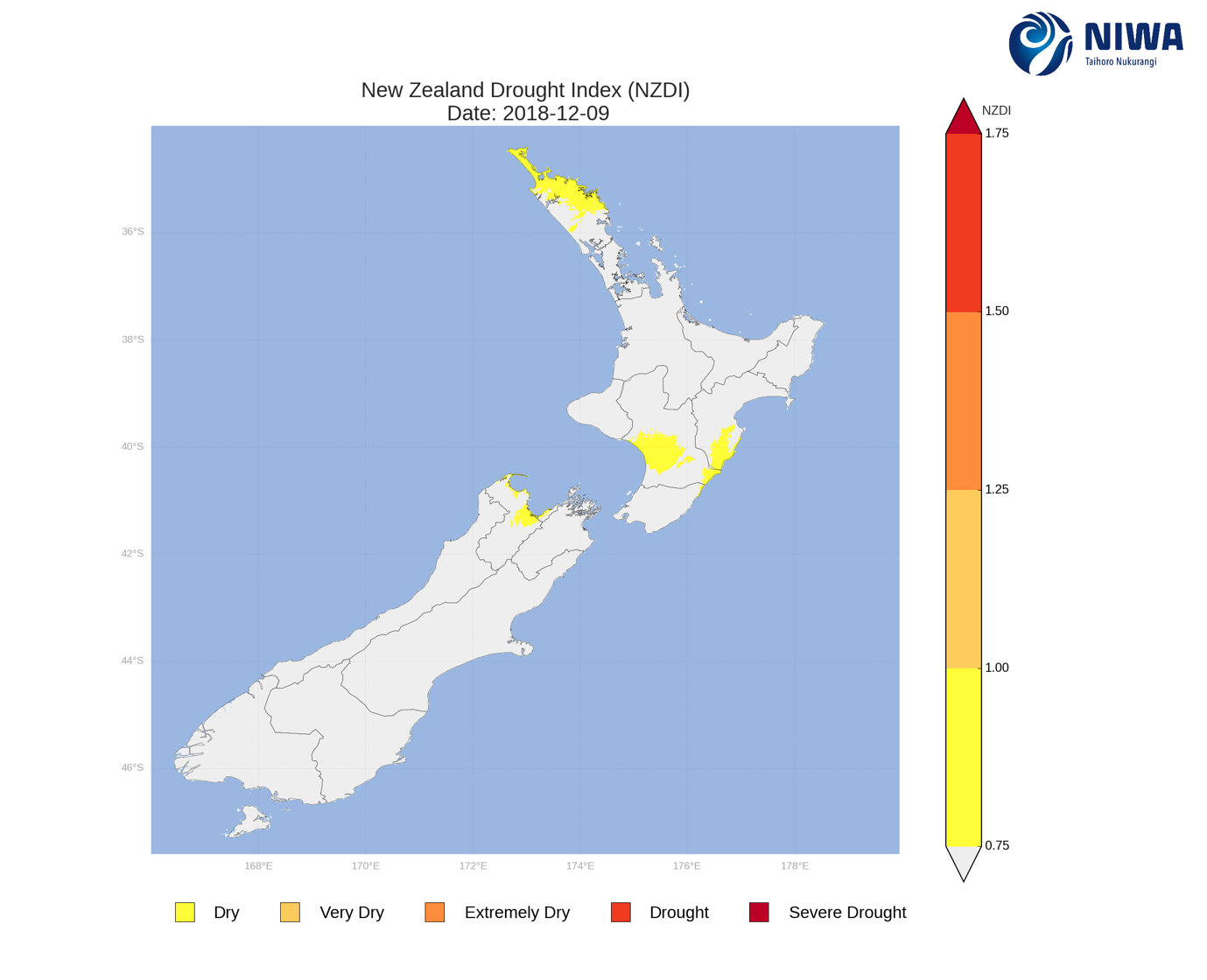NIWA's Hotspot Watch 12/12/18
Wednesday, 12 December 2018
NIWA's Hotspot Watch
A weekly update describing soil moisture across the country to help assess whether severely to extremely dry conditions are occurring or imminent. Regions experiencing these soil moisture deficits are deemed “hotspots”. Persistent hotspot regions have the potential to develop into drought.
Facts: Soil Moisture
Across the North Island, soil moisture levels generally decreased during the past week due to lower than average rainfall for this time of year. While decreases were observed nearly everywhere, the most notable change over the past week occurred in western Auckland and lower Northland, where soil moisture levels went from near normal to drier than normal for this time of year. Also, the Central Plateau to Manawatu-Whanganui saw a significant decrease in soil moisture in the past week. The only area that saw slight soil moisture increases during the past week was East Cape.
The driest soils across the North Island compared to normal for this time of the year are found in an area stretching from coastal Manawatu-Whanganui northeast to Taupo. The wettest soils for this time of the year are in coastal Wairarapa, East Cape, western Bay of Plenty and the Coromandel Peninsula. The hotspot in Manawatu-Whanganui grew over the last week and is now covering parts of the Rangitikei and Manawatu Districts.
Across the South Island, soils remained much wetter than normal for the time of year from central Canterbury to Southland. In addition, soil moisture levels are also above normal in the Kaikoura District. Conversely, soil moisture levels continued to decrease this week across Nelson, Tasman, and the West Coast.
The driest soils across the South Island compared to normal for this time of the year are found in far southern Westland District, while the wettest soils are located in southern Canterbury and coastal Otago. A small hotspot has emerged in Nelson in the past week.
Outlook and Soil Moisture
In the North Island, the unsettled weather will continue over the next several days due to low pressure situated in the Tasman Sea. Central areas may see rainfall exceeding 40 mm through Saturday (15th December). Similar rainfall is also expected in Wairarapa and the Gisborne Ranges. A more settled period is expected from Sunday (16th December) through mid-next week, but isolated showers may linger in the east and north.
With the rainfall amounts anticipated in the next week, additional soil moisture increases are possible in parts of the southern, central and eastern North Island with the greatest potential for soil moisture increase in the Central Plateau and Hawke’s Bay, particularly in the higher terrain. Soil moisture levels will likely remain the same or slightly decrease for the remainder of the North Island.
For the South Island, low pressure in the Tasman will continue to bring showers through Friday (14th December). Most of the rain is expected to fall in the north where total rainfall may reach 15-30 mm. The upcoming weekend looks drier for the South Island, but isolated showers may linger in the north. An approaching front may bring heavy falls to the West Coast on Tuesday and Wednesday (18th-19th December) with the most significant rainfall expected west of the divide.
With the rainfall amounts anticipated in the next week, soil moisture increases are expected along the West Coast, as well as parts of Tasman and Nelson. This will likely be shrinking and weakening the Nelson hotspot. Eastern areas will likely have little change or decrease slightly as weekly rainfall is expected to be normal or below normal.


Pictured above: Soil Moisture Anomaly Maps, relative to this time of year. The maps show soil moisture anomaly for the past two weeks.

The New Zealand Drought Index (NZDI) map below shows continuing dry areas across the North Island and upper South Island as of 9 December. Please note: the soil moisture anomaly map may not correspond with the NZDI map, mainly because the NZDI uses additional dryness indices including one which integrates the rainfall deficit over the past 60 days. Changes are therefore slower to appear in the NZDI compared to the instantaneous status maps of soil moisture anomaly.
Background:
Hotspot Watch a weekly advisory service for New Zealand media. It provides soil moisture and precipitation measurements around the country to help assess whether extremely dry conditions are imminent.
Soil moisture deficit: the amount of water needed to bring the soil moisture content back to field capacity, which is the maximum amount of water the soil can hold.
Soil moisture anomaly: the difference between the historical normal soil moisture deficit (or surplus) for a given time of year and actual soil moisture deficits.
Definitions: “Extremely” and “severely” dry soils are based on a combination of the current soil moisture status and the difference from normal soil moisture (see soil moisture maps at https://www.niwa.co.nz/climate/nz-drought-monitor/droughtindicatormaps)


 Bill Bennett: Chorus Fibre Data Surge Marks End Of 2024
Bill Bennett: Chorus Fibre Data Surge Marks End Of 2024 Glenn Banks & Regina Scheyvens, The Conversation: Luxon Goes All Out For Growth In Mining And Tourism – We Should Be Careful What He Wishes For
Glenn Banks & Regina Scheyvens, The Conversation: Luxon Goes All Out For Growth In Mining And Tourism – We Should Be Careful What He Wishes For Hugh Grant: 4 Common Mistakes Businesses Make When Launching Their Online Brand (and How To Avoid Them)
Hugh Grant: 4 Common Mistakes Businesses Make When Launching Their Online Brand (and How To Avoid Them) NZ Association of Scientists: Science System Advisory Group Report Receives Only Selective Engagement From Government
NZ Association of Scientists: Science System Advisory Group Report Receives Only Selective Engagement From Government New Zealand Defence Force: NZDF Celebrates Successful Launch Of A Second Satellite Payload
New Zealand Defence Force: NZDF Celebrates Successful Launch Of A Second Satellite Payload Universities New Zealand - Te Pokai Tara: Universities NZ Welcomes Findings In Science System Advisory Group Report
Universities New Zealand - Te Pokai Tara: Universities NZ Welcomes Findings In Science System Advisory Group Report



